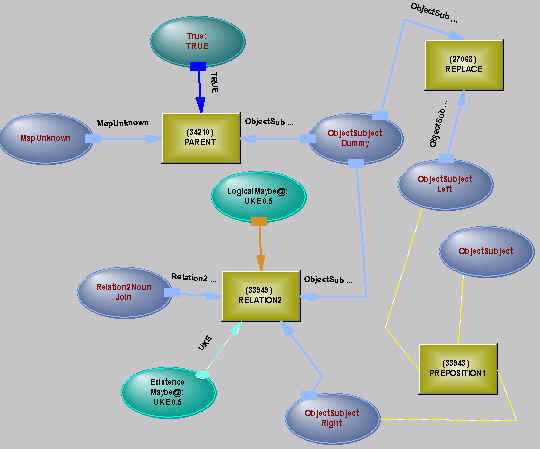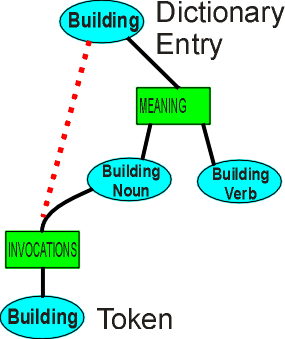Unpacking Noun Phrases
As a sentence is automatically parsed, the noun phrase is the first identifiable object used to probe in the knowledge model for a match. If we know what sort of object or relation the noun phrase describes, the system will be more able to decide which particular sense of the relation in the verb phrase operates on it - to eliminate ambiguity before it arises, in other words.
Noun phrases can already contain relations on objects - "the broken shaft", or relations on relations - "the broken promise", the "delivery delay".
Noun phrases range from the very simple
a fox
to the complicated
the broken and rusted motor shaft
We need to identify the object that the noun phrase describes in the knowledge model. Starting with the simplest -
"a fox"
The indefinite article tells us it is a new invocation of the object fox. We already built the invocation of fox - the word gave us the object - as we built the symbols to parse the sentence, so all that remains is to connect it into the current context.
"the fox"
The definite article tells us the object is already in the current context, so we do a match on those objects. If we find a match, we point the invocation we built to parse the sentence at the existing invocation, so other matching on the object will anchor on the object in the current context.
"the red fox"
We use HowConnected to work out that red is an alternative of the colour attribute of fox, set the attribute and try to match with a fox having the same attribute in the current context.
"the motor shaft"
We work out that shaft is a component of motor, so we create the linkage between the two objects (the shaft here is already an invocation of the base object shaft, as motor is of motor), and look for a match in the current context.
"the broken shaft"
Broken is a form of ToBreak, so we create a ToBreak relation and attach its object (second) parameter to shaft, and attempt to match it (we can't add the second parameter without adding the first, so that is attached to Unknown, which will match with anything). ToBreak can be intransitive - "the shaft broke" - or transitive - "the overload broke the shaft" - so we already have some ambiguity to handle.
"the broken motor shaft"
The operations are additive - shaft is a component of motor and has the relation ToBreak on it (it has a sense of ToBreak with its attribute FinishDate in the past because "broken" is a past participle, but that is another story).
Sometimes the word encapsulates the relation
The owner
Words like owner or builder or buyer contain a relation, which actively seeks out a target - the owner of what. By immediately building the relation with an unknown object, and linking that unknown object to the list of unknown objects in the sentence and then in the discourse, we are mimicking the creation of multiple parallel processes.
The building owner
The object and subject of thr ToOwn relation are provided by the text - the system uses a map to figure out how they should be connected (the map is a mechanism for prepositions and verb relations - a compound noun phrase is treated as though it had implicit prepositions):

The map contains criteria for matching (including active matching, where the map
changes as the matching proceeds), and instructions for building or rearrangement. In the
particular case, one node (building) replaces another (an unknown Ownable Thing). 
Dynamic Hierarchical Modification
As part of the operation of the map, the hierarchical linking of either object may change. In the case of "building owner", there are two meanings for "building" - either the present participle of ToBuild, or the noun, representing a physical entity. When the object for building becomes linked to the ToOwn relation, its connection is shifted from Building (with two meanings) to BuildingNoun - we are talking about a building. These small nips and tucks are how meaning emerges in the structure (and why you need a structure, and why it has to be active).
A similar map is used to handle
A company employee
where subject and object are in the normal direction, and employee immediately created a ToEmploy relation, with employee as object. There is a total of around ten maps for handling combinations in noun phrases, many of them being identical (except for rotation) with prepositional maps, such as
the building owner
the owner of the building
the building's owner (the possessive is treated as a prepositional form)
These are the basic operations of unpacking a noun phrase - connecting objects appropriately after we have found valid paths between them, or creating properly oriented relations on them.
Composite noun phrases contain prepositional phrases - see Prepositional Chains